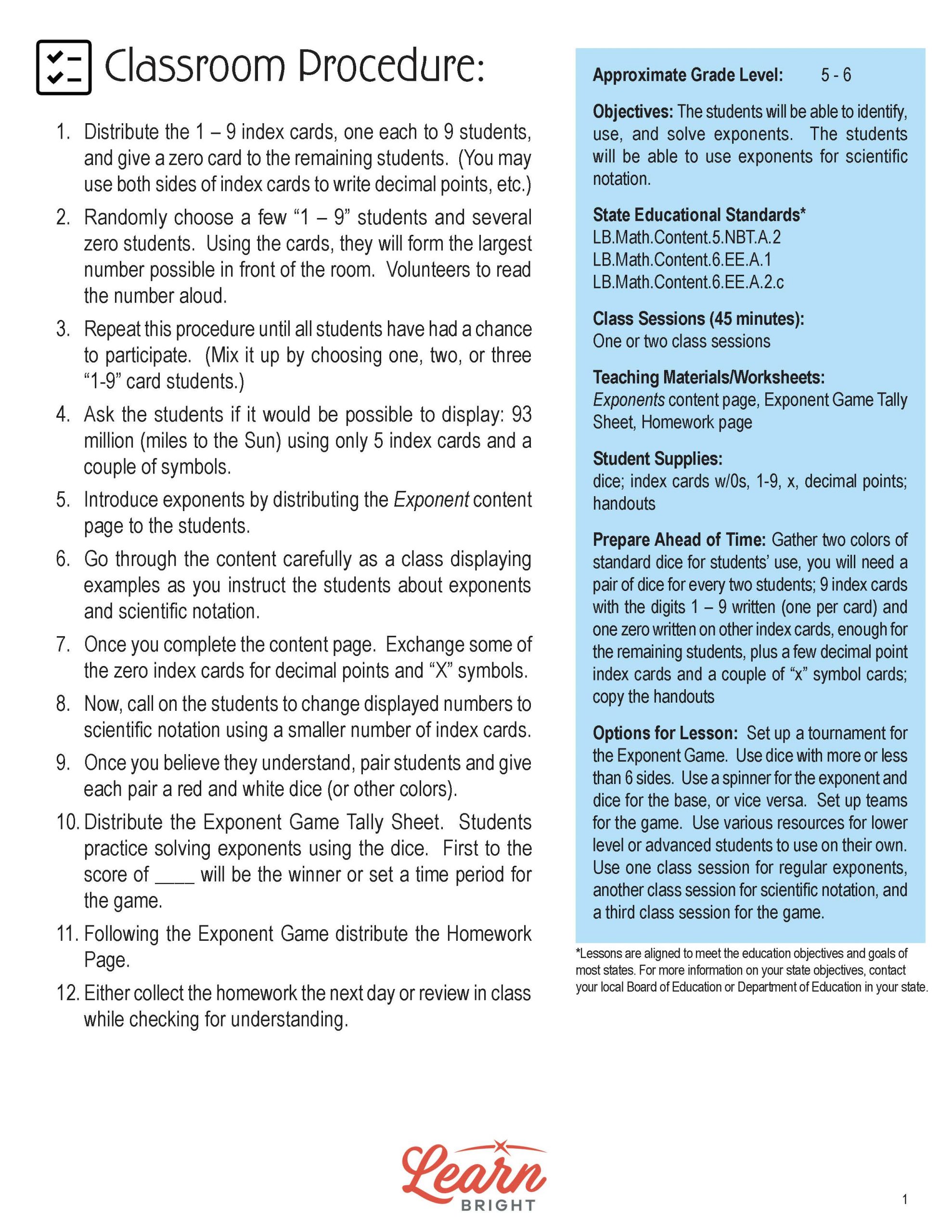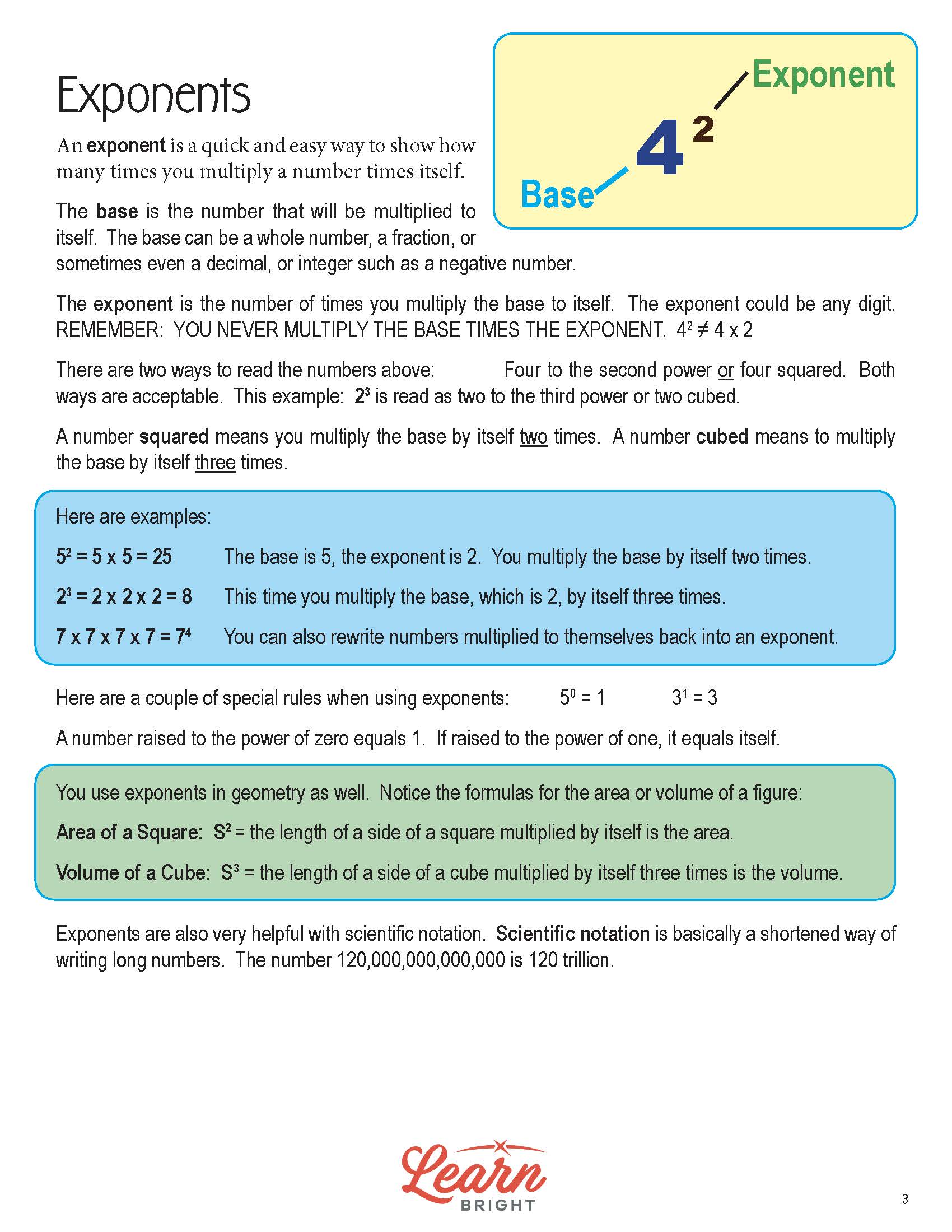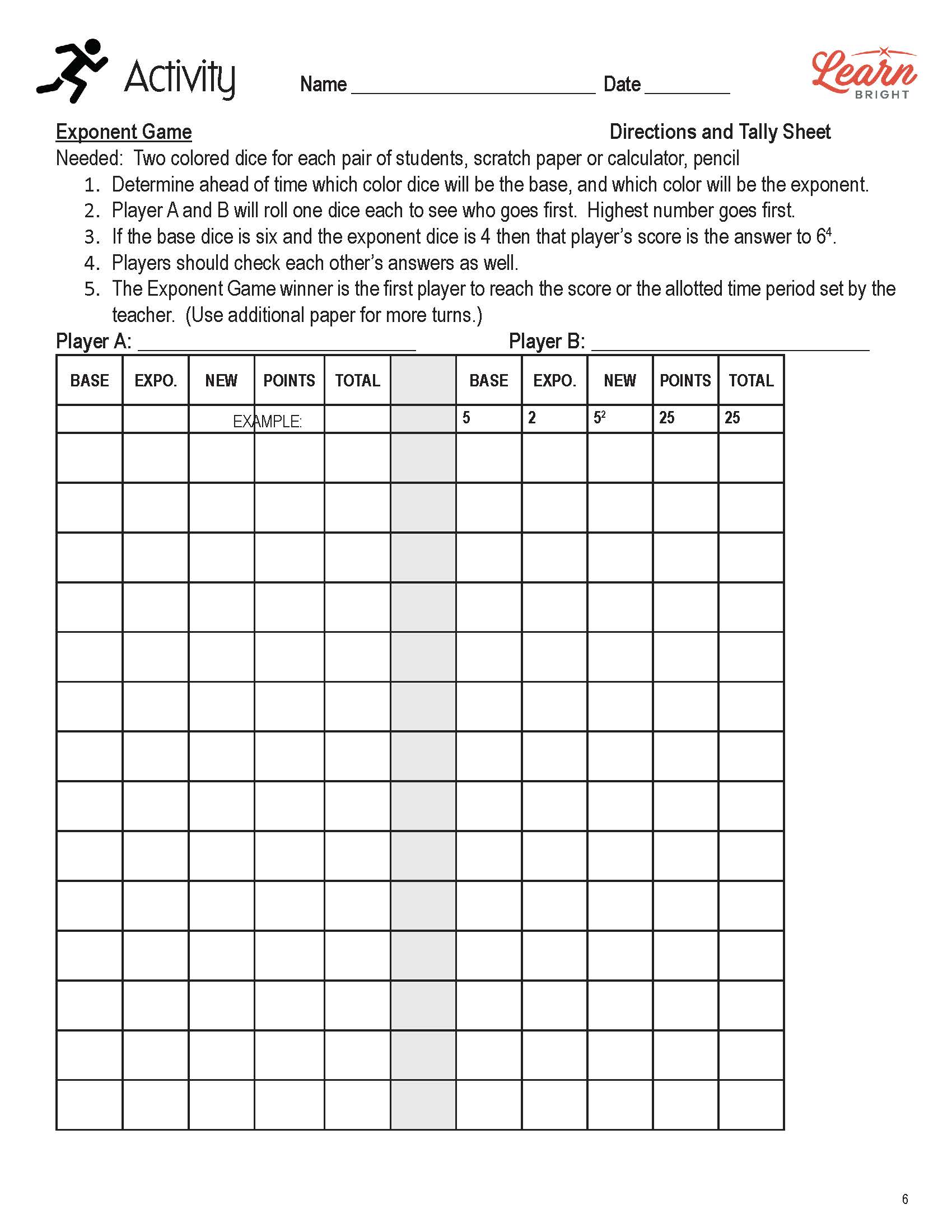Description
What our Exponents lesson plan includes
Lesson Objectives and Overview: Exponents teaches students how to identify and use exponents, and how to use them for scientific notation. This lesson plan is for students in 5th grade.
Classroom Procedure
Every lesson plan provides you with a classroom procedure page that outlines a step-by-step guide to follow. You do not have to follow the guide exactly. The guide helps you organize the lesson and details when to hand out worksheets. It also lists information in the blue box that you might find useful. You will find the lesson objectives, state standards, and number of class sessions the lesson should take to complete in this area. In addition, it describes the supplies you will need as well as what and how you need to prepare beforehand. The supplies you will need for this lesson are dice, index cards, and the handouts.
Options for Lesson
Included with this lesson is an “Options for Lesson” section that lists a number of suggestions for activities to add to the lesson or substitutions for the ones already in the lesson. Almost all of the suggestions are for the lesson activity. One optional addition to the activity is to set up a tournament for the Exponent Game. For the activity, you can also use dice with more or less than 6 sides or use a spinner for the exponent and dice for the base, or vice versa. You can also set up teams for the game. To add to the lesson, you can use various resources for lower level or advanced students to explore on their own. Finally, you can use one class session for regular exponents, another class session for scientific notation, and a third class session for the game.
Teacher Notes
The teacher notes page includes a paragraph with additional guidelines and things to think about as you begin to plan your lesson. This page also includes lines that you can use to add your own notes as you’re preparing for this lesson.
EXPONENTS LESSON PLAN CONTENT PAGES
Exponents
The Exponents lesson plan includes two content pages. Exponents are quick and easy ways to show how many times you need to multiply a number by itself. In an exponent, the base is the number that you multiply to itself. Bases can be whole numbers, a fraction, a decimal, or an integer like a negative number. The exponent is the number of times you multiply the base to itself. Exponents can be any digit. It’s important to remember that you never multiply the base by the exponent.
You can read the exponent 4^2 as four to the second power or four squared. You read 2^3 as two to the third power or two cubed.
When you multiply the base by itself two times, we call it squaring the number. When you multiply it by itself three times, we call it cubing the number.
The lesson includes several examples. One of these is 5^2 = 5 x 5 = 25. In this example, the base is 5 and the exponent is 2. You multiply the base (5) by itself two times.
A number raised to the power of zero (when zero is the exponent), the answer is 1. When we raise it to the power of one (when one is the exponent), the answer is the base number.
We also use exponents in geometric equations. The formula for the area of a square is S^2, or the length of a side of a square multiplied by itself is the area. The formula for the volume of a cube is S^3, or the length of a side of a cube multiplied by itself three times is the volume.
We also use exponents for scientific notation. This is basically just a shortened way of writing very long numbers. For example, the number 120,000,000,000,000 is 120 trillion. We can use scientific notation to write it in a shorter way that is easier to read.
First, we move the decimal from right to left, creating a new number greater than 1 but less than 10. In this example, we move it 14 times, so the new number is 1.2. Next, you rewrite it with an exponent: 1.2 x 10^14. We always use the base 10 in scientific notation. The exponent is always the number of places we move the decimal over (in this case, 14). The lesson includes a few more scientific notation examples.
We also use scientific notation to write very small decimal numbers using negative exponents. For example, 0.0000075 = 7.5 x 10^-6. We move the decimal six times from right to left so the exponent is -6.
When you solve problems with exponents, you need to solve inside of the parenthesis first and then solve for the exponents.
EXPONENTS LESSON PLAN WORKSHEETS
The Exponents lesson plan includes two worksheets: an activity worksheet and a homework assignment. You can refer to the guide on the classroom procedure page to determine when to hand out each worksheet.
EXPONENT GAME ACTIVITY WORKSHEET
Students will play the exponent game with a partner for the activity. Each pair will have two differently-colored dice and will determine which color dice represents the exponent and which represents the base. They will take turns rolling both dice and solving the exponent to determine their score for each round. For example, if they roll a 6 on the base dice and a 4 on the exponent dice, their score is 1296. Students will double-check each other’s scores.
EXPONENTS HOMEWORK ASSIGNMENT
For the homework assignment, students will complete a few short exercises. First, they will answer four questions about exponents. Next, they will write the base and exponent for four equations and then solve them. They will then solve 12 problems containing exponents. Next, they will rewrite eight problems using scientific notation and write the whole number. Finally, they will solve three problems, two of which are word problems.
Worksheet Answer Keys
This lesson plan includes answer keys for the homework assignment. If you choose to administer the lesson pages to your students via PDF, you will need to save a new file that omits this page. Otherwise, you can simply print out the applicable pages and keep these as reference for yourself when grading assignments.









